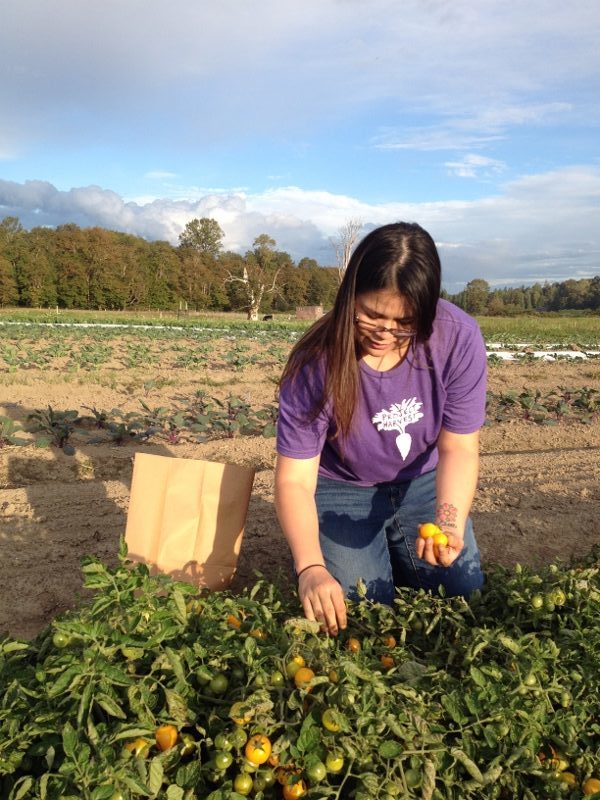How Can We Help?
You are here:
< All Topics
Prior to Glean:
Coordinate with farmers. Make a list of info you need from farmers to effectively and efficiently coordinate gleaning events. This includes:
- type of produce,
- number of volunteers needed for a 2-3 hours harvest,
- best hours for farm to have volunteers (some farms are very busy on certain days and would prefer to keep employees/volunteers separate),
- parking,
- crop location,
- potential concerns, if it is a selective harvest versus a full harvest, and
- the harvest method preferred.
Gleaning Event Steps:
Before Volunteers Arrive:
- Meet with farmers 20-30 minutes before the gleaning event for harvesting instructions.
- Determine ahead of time if the farmer would like you to wash produce. If so, ask for training on using the wash station if possible.
- Move the car near the harvesting site if possible.
Volunteers Arrive
- Greet gleaners and direct them to parking.
- Make sure everyone is signed in/documents signed (waiver of liability/parental consent forms) if needed.
Orient Field Gleaners:
If possible, send terms of participation before the event to volunteers via email; highlight the essential parts during the orientation.
- Represent the program in a positive manner at all times: Farmers are donors and gleaners are guests on their property. Highlight to volunteers to be respectful to produce, property, and each other! This is good to note in terms of participation.
- No smoking on farm: smoking is very bad for plant quality and can actually damage or kill tomato crops!
- Safety first: Instruct volunteers to work at their own pace, know their limits, and communicate with the gleaning coordinator if they need help or a break. Remind volunteers if they feel they cannot lift something to ask for help. Let volunteers know if they are unsure about something to ask the gleaning coordinator.
Food/Farm Safety Practices
- Hands should be washed (well) before harvesting produce.
- If a volunteer is sick, do not have them volunteer harvesting the produce.
- If the volunteer has a cut on their hands, have them put a bandage over the wound (a glove over top is highly advised).
- Advise volunteers to not touch their face/scalp while harvesting (similar to restaurant expectations… even though outside).
- Sneeze into the arm, or wipe your face with an arm.
- Snacks should be consumed away from packing/harvesting.
- Common Sources of Contamination in Agriculture:
- During Production: Manure, Irrigation Systems, Animal Droppings
- During Harvest: Field Workers’ improper Hygiene or harvesting practices
Harvesting Techniques for food safety and produce quality
- Keep an eye out for animal droppings, and do not harvest produce near droppings.
- On hot days, limit the length of the harvest to get produce into refrigeration.
- Pack greens loosely, even if it means less storage space.
- Handle produce carefully, do not toss vegetables into crates (prevent bruising).
- Time leafy green harvests when it is cooler out. Evening/Morning harvests are ideal! This is not always possible when working around a farm’s schedule (sometimes they prefer to keep farm harvesting hours separate from volunteer events. If harvesting in the heat/sun use your body to shade the harvest bin and store produce in a shady area.
Set up Harvesting plan with volunteers:
- Where you are harvesting/how much (selective harvest or full harvest). It is great to use flags to mark where to stop harvesting.
- Packing method: In-field packing versus harvesting tubs to transfer to a storage container (discuss this with the farmer to develop the best plan for the gleaning program’s resources and the farm’s preference).
- Washing produce: Some farmers may prefer you to wash their produce (mostly due to bug pressure) after harvest. They may allow you to utilize their washstand. Train volunteers to do so (Tip: suggest that volunteers let produce go if it falls on the washstand floor).
- Harvest!
- Take Photos: nothing is better than taking photos at gleans to boost your marketing materials! Post on Facebook page to tell the story of your gleaning program.
- Take Breaks if needed!
Wrap up Glean:
- Make sure nothing is left in the field (leave crop as you found it).
- Thank volunteers.
- If possible thank farmers or farm employees if they are around.
- After returning to the storage facility:
- Weigh produce,
- Put in refrigerator/room temp depending on produce,
- Document gleaned produce poundage,
- Document volunteer hours,
- Send thank you note/receipt to the farmer.
Gleaning Event Supplies
Storage: The most essential equipment needed is produce storage. Produce storage options include:
- Banana boxes from local food banks: Recommend using food-grade clear trash bags/can liners for greens to line banana boxes, or just use can liners if harvesting greens (provides great humidity control/ensures sanitation).
- Plastic Food Grade food bins or crates
Harvest Tools for Row Crops: Very little equipment is needed to get the program off its feet in the first year because many crops are harvested by hand.
- Harvest knives- keep an eye out for serrated knives at local thrift stores.
- Pitch Forks: many root vegetables can be pulled out of the ground without using pitch forks, although they may come in handy for those tricky root vegetables that give you a hard time!
- Garden Gloves: Gloves are great for gleaning squash/zucchini, the vines are prickly!
Miscellaneous:
- Hand Sanitizer: great for gleans when you cannot utilize a bathroom to wash hands prior
- First Aid Kit
What to pack/wear (Gleaning Coordinator and Volunteers):
- Water Bottle (some farmers request no glass)
- Hat/Sunscreen/Sunglasses
- Garden Appropriate Clothing
- Snack if long glean – eat away from crop and wash hands after snack



